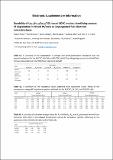Files in this item
Durability of La0.20Sr0.25Ca0.45TiO3-based SOFC anodes : identifying sources of degradation in Ni and Pt/ceria co-impregnated fuel electrode microstructures
Item metadata
| dc.contributor.author | Price, Robert | |
| dc.contributor.author | Weissen, Ueli | |
| dc.contributor.author | Grolig, Jan G. | |
| dc.contributor.author | Cassidy, Mark | |
| dc.contributor.author | Mai, Andreas | |
| dc.contributor.author | Irvine, John T. S. | |
| dc.date.accessioned | 2022-04-07T23:46:49Z | |
| dc.date.available | 2022-04-07T23:46:49Z | |
| dc.date.issued | 2021-04-28 | |
| dc.identifier | 273967508 | |
| dc.identifier | 7dc87294-2c6d-46e5-a677-1ab7136c3c62 | |
| dc.identifier | 85104930390 | |
| dc.identifier | 000640255700001 | |
| dc.identifier.citation | Price , R , Weissen , U , Grolig , J G , Cassidy , M , Mai , A & Irvine , J T S 2021 , ' Durability of La 0.20 Sr 0.25 Ca 0.45 TiO 3- based SOFC anodes : identifying sources of degradation in Ni and Pt/ceria co-impregnated fuel electrode microstructures ' , Journal of Materials Chemistry A , vol. 9 , no. 16 , pp. 10404-10418 . https://doi.org/10.1039/d1ta00416f | en |
| dc.identifier.issn | 2050-7488 | |
| dc.identifier.other | Jisc: 72e6364087794857ad9e3f8ad2d8cf75 | |
| dc.identifier.other | ORCID: /0000-0002-8394-3359/work/93161282 | |
| dc.identifier.uri | https://hdl.handle.net/10023/25160 | |
| dc.description | Funding from the University of St Andrews and HEXIS AG is acknowledged, in addition to the EPSRC Grants: EP/M014304/1 “Tailoring of Microstructural Evolution in Impregnated SOFC Electrodes” and EP/L017008/1 “Capital for Great Technologies”. | en |
| dc.description.abstract | Solid oxide fuel cells (SOFC) comprising LSM-YSZ/LSM composite cathodes, 6ScSZ electrolytes and La0.20Sr0.25Ca0.45TiO3 (LSCTA−) anode ‘backbone’ microstructures were prepared using thick-film ceramic processing techniques. Activation and decoration of the LSCTA− anode ‘backbone’ with electrocatalytic coatings of cerium-based oxides and metallic Ni or Pt particles was achieved using the technique of catalyst co-impregnation. SOFC containing Ni/CGO, Ni/CeO2 and Pt/CGO impregnated LSCTA anodes were tested up to ∼1000 hours by the Swiss SOFC manufacturer: HEXIS, under realistic operating conditions, including 15 redox, thermo and thermoredox cycles. The voltage degradation rates observed over the entire test period for the SOFC containing the Ni/CGO, Ni/CeO2 and Pt/CGO impregnated LSCTA− anodes were 14.9%, 7.7% and 13.4%, respectively. Post-mortem microscopic analyses indicated that CeO2 formed ubiquitous coatings upon the LSCTA− anode microstructure, allowing retention of a high population density of metallic (Ni) particles, whilst CGO formed ‘islands’ upon the microstructure and some agglomerates within the pores, leading to more facile agglomeration of metallic (Ni and Pt) nanoparticles. Correlation of the post-mortem microscopy with AC impedance analysis revealed that the agglomeration of metallic catalyst resulted in an increase in the high-frequency anode polarisation resistance, whilst agglomeration of the ceria-based component directly resulted in the development of a low-frequency process that may be attributed to combined contributions from gas conversion and chemical capacitance. | |
| dc.format.extent | 2503946 | |
| dc.format.extent | 248129 | |
| dc.language.iso | eng | |
| dc.relation.ispartof | Journal of Materials Chemistry A | en |
| dc.subject | QD Chemistry | en |
| dc.subject | E-NDAS | en |
| dc.subject.lcc | QD | en |
| dc.title | Durability of La0.20Sr0.25Ca0.45TiO3-based SOFC anodes : identifying sources of degradation in Ni and Pt/ceria co-impregnated fuel electrode microstructures | en |
| dc.type | Journal article | en |
| dc.contributor.sponsor | EPSRC | en |
| dc.contributor.sponsor | EPSRC | en |
| dc.contributor.institution | University of St Andrews. School of Chemistry | en |
| dc.contributor.institution | University of St Andrews. Centre for Designer Quantum Materials | en |
| dc.contributor.institution | University of St Andrews. EaSTCHEM | en |
| dc.identifier.doi | 10.1039/d1ta00416f | |
| dc.description.status | Peer reviewed | en |
| dc.date.embargoedUntil | 2022-04-08 | |
| dc.identifier.grantnumber | EP/M014304/1 | en |
| dc.identifier.grantnumber | ep/l017008/1 | en |
This item appears in the following Collection(s)
Items in the St Andrews Research Repository are protected by copyright, with all rights reserved, unless otherwise indicated.


